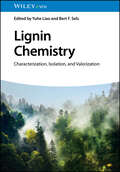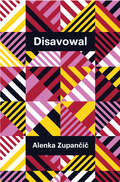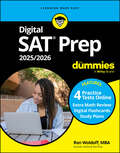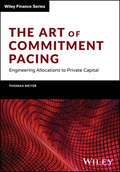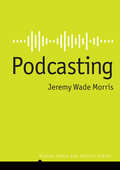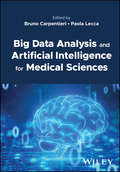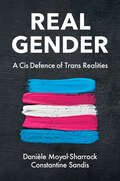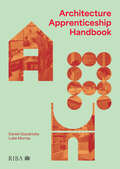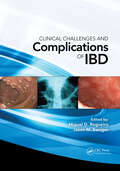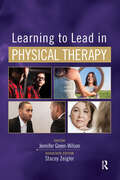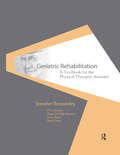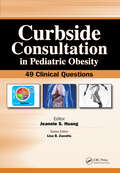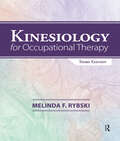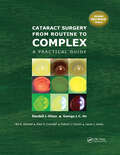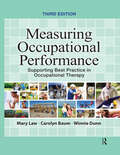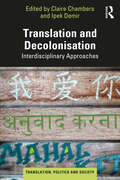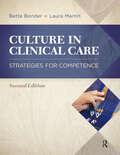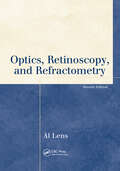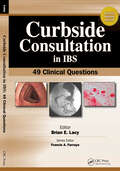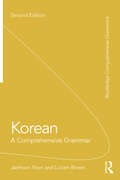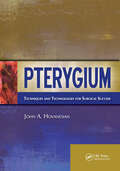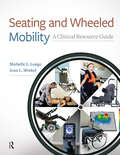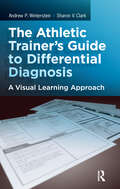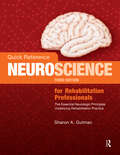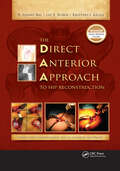- Table View
- List View
Lignin Chemistry: Characterization, Isolation, and Valorization
by Bert F. Sels Yuhe LiaoLignin Chemistry A thorough reference guide to Lignin Chemistry, from inherent structure revealing to transformation into chemicals, fuels, and materials Climate change, driven by rising greenhouse gas emissions, is the defining challenge of our time. Reducing our dependence on non-renewable resources such as fossil fuels will require alternative, more sustainable resources. Lignin, the only widely-occurring, renewable, aromatic bio-polymer in Nature, has a range of application potential in the production of chemicals, fuels, and other industrial materials. Lignin science has become one of the fastest-growing and most significant areas of sustainable chemistry in the world. Lignin Chemistry: Characterization, Isolation, and Valorization presents a systematic, multidisciplinary overview of this cutting-edge field and its current state of research. Beginning with a robust characterization of lignin, the book addresses the isolation and transformation of lignin, as well as the book inspires with a plethora of applications. The result is a critical resource for researchers and professionals in any area of academic or industry where renewable biomass, in particular lignin, has importance. Lignin Chemistry readers will find: Thermochemical and catalytic strategies for lignin conversionDetailed discussion of the valorization of lignin towards biopolymers, nanoparticles, carbon fibers and materials, and hydrogelsAn authorial team with immense and varied research experience Lignin Chemistry is ideal for chemical engineers, catalytic chemists, biochemists, material scientists, and analytical chemists in industry.
Disavowal (Theory Redux)
by Alenka ZupančičThis book argues that the psychoanalytic concept of disavowal best renders the structure underlying our contemporary social response to traumatic and disturbing events, from climate change to unsettling tectonic shifts in our social tissue. Unlike denialism and negation, disavowal functions by fully acknowledging what we disavow. Zupančič contends that disavowal, which sustains some belief by means of ardently proclaiming the knowledge of the opposite, is becoming a predominant feature of our social and political life. She also shows how the libidinal economy of disavowal is a key element of capitalist economy. The concept of fetishistic disavowal already exposes the objectified side of the mechanism of the disavowal, which follows the general formula: I know well, but all the same, the object-fetish allows me to disregard this knowledge. Zupančič adds another twist by showing how, in the prevailing structure of disavowal today, the mere act of declaring that we know becomes itself an object-fetish by which we intercept the reality of that very knowledge. This perverse deployment of knowledge deprives it of any reality.This structure of disavowal can be found not only in the more extreme and dramatic cases of conspiracy theories and re-emerging magical thinking, but even more so in the supposedly sober continuation of business as usual, combined with the call to adapt to the new reality. To disrupt this social embedding of disavowal, it is not enough to change the way we think: things need to change, and hence the way they think for us.
Digital SAT Prep 2025/2026 For Dummies: Book + 4 Practice Tests + Flashcards Online
by Ron WoldoffGet the score you need to land scholarships and get into the school of your dreams The SAT is a crucial step in the college admissions process, and a high score can put you on the road to the future you're dreaming of. Digital SAT Prep 2025/2026 For Dummies gives you the building blocks you need to take the test with confidence. First, get a primer on all the concepts tested on the SAT and find handy strategies for test day to boost your score. Then, apply what you've learned, with four practice tests online, complete with detailed answer explanations. New digital flashcards quiz you on your math and verbal skills, and detailed study plans help you stay on track. With this no-nonsense Dummies guide, you have everything you need to knock the SAT out of the park. Get clear explanations of all the content on the digital SAT, plus practice questions with answer explanations Quiz your heart out with 4 full-length practice tests and flashcards online Follow a customizable study plan, so you know you're making the most of the time you have left before the test Improve your chances of getting into your top-choice colleges with a high SAT score Digital SAT Prep 2025/2026 For Dummies is for anyone looking for that extra edge on this all-important college entrance exam.
The Art of Commitment Pacing: Engineering Allocations to Private Capital (The Wiley Finance Series)
by Thomas MeyerAdvanced guidance for institutional investors, academics, and researchers on how to manage a portfolio of private capital funds The Art of Commitment Pacing: Engineering Allocations to Private Capital provides a much-needed analysis of the issues that face investors as they incorporate closed ended-funds targeting illiquid private assets (such as private equity, private debt, infrastructure, real estate) into their portfolios. These private capital funds, once considered "alternative" and viewed as experimental, are becoming an increasingly standard component of institutional asset allocations. However, many investors still follow management approaches that remain anchored in the portfolio theory for liquid assets but that often lead to disappointing results when applied to portfolios of private capital funds where practically investors remain committed over nearly a decade. When planning for such commitments, investment managers and researchers are faced with practical questions such as: How to measure and control the real exposure to private assets? How to forecast cash-flows for commitments to private capital funds? What ranges for their returns and lifetime are realistic, and how can the investor’s skill be factored in? Over which dimensions should a portfolio be diversified and how much diversification is enough? How can the impact of co-investments or secondaries be modelled? How to design pacing plans that lead to resilient and efficient portfolios? What stress scenarios should be considered and how can they be applied? These are just examples of the many questions for which answers are provided. The Art of Commitment Pacing describes established and new methodologies for building up and controlling allocations to such investments. This book offers a systematic approach for building up and controlling allocations to such investments. The Art of Commitment Pacing is a valuable addition to the libraries of investment managers, as well as portfolio and risk managers involved in institutional investment. The book will also be of interest to advanced students of finance, researchers, and other practitioners who require a detailed understanding of forecasting and portfolio management methodologies.
Podcasting (Digital Media and Society)
by Jeremy Wade MorrisPodcasting burst onto the media landscape in the early 2000s. At the time, there were hopes it might usher in a new wave of amateur and professional cultural production and represent an alternate model for how to produce, share, circulate and experience new voices and perspectives. Twenty years later, podcasting is at a critical juncture in its young history: a moment where the early ideals of open standards and platform-neutral distribution are giving way to services that prioritize lean-back listening and monetizable media experiences. This book provides an accessible and comprehensive account of one of digital media’s most vibrant formats. Focusing on the historical changes shaping podcasts as a media format, the book explores the industrial, technological and cultural components of podcasting alongside case studies of various podcasts, industry publications, and streaming audio platforms (e.g. Spotify, Google and Apple Podcasts). Jeremy Morris argues that as streaming platforms push to make podcasting more industrialized, accessible, user-friendly and similar to other audio media like music or audiobooks, they threaten podcasting’s early, though always unrealized, promises. This is the go-to introduction for students and researchers of media, communication and cultural studies, as well as readers who enjoy making and listening to podcasts.
Big Data Analysis and Artificial Intelligence for Medical Sciences
by Paola Lecca Bruno CarpentieriBig Data Analysis and Artificial Intelligence for Medical Sciences Overview of the current state of the art on the use of artificial intelligence in medicine and biology Big Data Analysis and Artificial Intelligence for Medical Sciences demonstrates the efforts made in the fields of Computational Biology and medical sciences to design and implement robust, accurate, and efficient computer algorithms for modeling the behavior of complex biological systems much faster than using traditional modeling approaches based solely on theory. With chapters written by international experts in the field of medical and biological research, Big Data Analysis and Artificial Intelligence for Medical Sciences includes information on: Studies conducted by the authors which are the result of years of interdisciplinary collaborations with clinicians, computer scientists, mathematicians, and engineers Differences between traditional computational approaches to data processing (those of mathematical biology) versus the experiment-data-theory-model-validation cycle Existing approaches to the use of big data in the healthcare industry, such as through IBM’s Watson Oncology, Microsoft’s Hanover, and Google’s DeepMind Difficulties in the field that have arisen as a result of technological changes, and potential future directions these changes may take A timely and up-to-date resource on the integration of artificial intelligence in medicine and biology, Big Data Analysis and Artificial Intelligence for Medical Sciences is of great benefit not only to professional scholars, but also MSc or PhD program students eager to explore advancement in the field.
Real Gender: A Cis Defence of Trans Realities
by Constantine Sandis Danièle Moyal-SharrockSocieties around the world are struggling to think clearly about trans realities and understand trans identities. Real Gender is the first book to present a cis defence of what it means to be transgender. Moyal-Sharrock and Sandis delve into the various factors which make many trans people’s experience of their gender (or lack thereof) as natural and unquestionable as that of cis people. While recognising the undeniably social aspects of gender, they find that gender cannot be completely divorced from our biological underpinnings. Contrary to popular opinion, gender self-identification does not require the denial of either biology or sex. What is needed is a more liberal understanding of our gender concepts, which would prevent us from confusing diversity with pathology. Steeped in published and personal trans testimonials, Real Gender does not seek to provoke or attack, but to unequivocally defend trans realities. A powerful exploration of a divisive topic, this book will be of interest to a wide audience of readers.
Architecture Apprenticeship Handbook
by Daniel Goodricke Luke MurrayArchitecture apprenticeships are a new route into the profession. Having gained traction since their inception in 2018, it is an attractive route for young generations of architects to obtain their professional qualifications and earn while they learn. Aimed at prospective and current Level 7: Architect Apprentices, this guide provides the knowledge to achieve the most from your apprenticeship education, empowering your exposure in the profession within academic and professional areas. Taking you on a journey through the apprenticeship, it presents key stages of the course through precedents and will let you know what to expect from this educational route, and when to expect it. Using case studies from recent graduates and current apprentices who have excelled through this route, it features information from employers and academics involved in architecture apprenticeship courses in the UK to provide tips, advice and guidance. Designed to be interactive, you will be able to populate and annotate the book at various stages to map the key stages of your journey and reflect on your professional development.
Clinical Challenges and Complications of IBD
by Miguel Regueiro Jason SwogerPhysicians treating patients with Inflammatory Bowel Disease (IBD) often face challenges due to the disease itself, associated conditions, and systemic effects. Recently, new medications have been introduced that allow for more aggressive and effective treatment of IBD. With these medications come the risks of adverse side effects, and physicians must vigilantly monitor for any complications. Drs. Miguel D. Regueiro and Jason Swoger have created a unique, user-friendly book that describes how to prevent, recognize, and manage complications encountered in the care of patients with IBD. Clinical Challenges and Complications of IBD aims to provide practical and clinically oriented information to assist physicians with commonly encountered complications of the natural history of IBD, extraintestinal manifestations of IBD, general health and metabolic complications of IBD, and complications arising from both the medical and surgical treatments of IBD. Formatted to allow for quick access of the information, Clinical Challenges and Complications of IBD is organized into sections that allow physicians to both identify potential pitfalls in treatment, as well as focus on health maintenance and specific challenges, including pregnancy, nutrition, and psychological issues. Clinical pearls will be emphasized and each chapter will provide a bulleted summary, along with suggestions for future reading.Clinical Challenges and Complications of IBD is an invaluable guide for gastroenterologists, nurse practitioners, physician assistants, and gastroenterology trainees as it is a one-of-a-kind resource for recognizing and dealing with the challenges and complications in patients with IBD.
Learning to Lead in Physical Therapy
by Jennifer Green-Wilson Stacey ZeiglerA timely and essential book for physical therapist and physical therapist assistant students, faculty, and practitioners, as well as clinical educators, Learning to Lead in Physical Therapy provides information on identifying, developing, and demonstrating effective leadership skills for daily practice.Drs. Jennifer Green-Wilson and Stacey Zeigler explain that in a health care field that’s constantly evolving, leadership skill development must be a high priority in physical therapy education and practice. Leadership skills are critical for physical therapists and physical therapist assistants throughout the course of their careers—in an informal leadership role with patients, in collaboration and advocacy for interdisciplinary care, and in formal leadership positions as they continually adapt to new expectations.With an evidence-based framework, the authors incorporate a workbook-style text with written prompts, activities, tools, quotes, and personal vignettes from practicing clinicians to explore concepts including: Discovering your individual strengths, developing your leadership style, and learning to lead through mentorship and coaching Communicating effectively, incorporating teamwork and collaboration, becoming an inclusive leader, and leading through conflict Effecting change through leadership, ethical decision-making, and serving others This book is easily incorporated within a single course or across multiple courses throughout a curriculum. Academic and clinical faculty and practitioners will also find this book easy to use for personal growth with its activity-based guidance through each chapter.Included with the text are online supplemental materials for faculty use in the classroom.Physical therapists and physical therapist assistants have the unique opportunity to be leaders at all levels—in their practices, the health care system, and their communities at large. Learning to Lead in Physical Therapy is an essential text in preparing students, faculty, and practitioners of all levels for these crucial leadership roles and responsibilities.
Geriatric Rehabilitation: A Textbook for the Physical Therapist Assistant (Core Texts for PTA Education)
by Jennifer BottomleyAs the aging population continues to increase, so does the need for a text specific to the specialized care of the elderly patient as it applies to the physical therapist assistant student, faculty, and clinician. Geriatric Rehabilitation: A Textbook for the Physical Therapist Assistant, recognizes the growing role of the PTA in a variety of heath care settings from acute to home to long-term care settings, to name a few.Inside Geriatric Rehabilitation, Dr. Jennifer Bottomley, along with her contributors, focuses on the clinically relevant assessment, treatment, and management of the geriatric population. Pathological manifestations commonly seen in the elderly patient are addressed from a systems perspective, as well as a focus on what is seen clinically and how it affects function. Each pathological area covered includes: • Screening, assessment, and evaluation • Treatment prescription• Goal setting• Modification of treatment• Anticipated outcomes• Psychosocial, pharmacological, and nutritional elementsThe organization and presentation of the practical, hands-on components of interventions, assessments, and decision-making skills make this a go-to text for the PTA to administer comprehensive geriatric care at each point along the continuum of care.Some of the features inside include:• Emphasis on treatment interventions–techniques, tips, and options• Focus on how assessment tools and treatments are applied and modified to benefit the geriatric population, and what the expected outcomes are• Clear and outlined chapter objectives• User-friendly summary tables in the nutritional and pharmacology chapters• Pearls that highlight important chapter information• Appendices and study aidsGeriatric Rehabilitation: A Textbook for the Physical Therapist Assistant answers the call for a text that focuses on the management of geriatric patients across the spectrum of care for the PTA, from students to those practicing in geriatric populations.
Curbside Consultation in Pediatric Obesity: 49 Clinical Questions (Curbside Consultation in Pediatrics)
by Jeannie HuangAre you looking for concise, practical answers to those questions that are often left unanswered by traditional pediatric obesity references? Are you seeking brief, evidence-based advice for complicated cases or controversial decisions? Curbside Consultation in Pediatric Obesity: 49 Clinical Questions provides quick answers to the tricky questions most commonly posed during a “curbside consultation” between pediatricians. Dr. Jeannie Huang has designed this unique reference which offers expert advice, preferences, and opinions on tough clinical questions commonly associated with pediatric obesity. The unique Q&A format provides quick access to current information related to pediatric obesity with the simplicity of a conversation between two colleagues. Numerous images, diagrams, and references allow readers to browse large amounts of information in an expedited fashion. Some of the questions that are answered: • How can a primary care practitioner manage obesity? • My patients often ask me about fad diets for weight loss. What is the bottom line about fad diets - are they benign or do some have associated adverse risks? • What are some of the behavioral programs available for obese children and how do I choose which would be the most appropriate for my obese patients? • I am often asked about bariatric surgery. What are the different weight loss surgeries for pediatric patients? What are the important considerations, associated complications, and effectiveness of each type of surgery? • How do I get reimbursed for delivery of weight management therapies in the office?• Are there any effective technologies (apps, sensors) available to help pediatric patients lose weight?Curbside Consultation in Pediatric Obesity: 49 Clinical Questions provides information basic enough for residents while also incorporating expert advice that even high-volume pediatricians will appreciate. Pediatricians, nurse practitioners, physician assistants, and family practitioners will benefit from the user-friendly, casual format and the expert advice contained within.
Kinesiology for Occupational Therapy
by Melinda RybskiKinesiology for Occupational Therapy, Third Edition covers the theoretical background for understanding the kinematics and kinetics of normal human physiological movement. Each specific joint is assessed in terms of musculoskeletal function, movements possible, and an overview of pathology that may develop. Dr. Melinda Rybski covers four occupational therapy theories related to functional motion that are important for occupational therapists to know. This Third Edition has been updated to reflect the current field and includes new information that has emerged in recent years. New in the Third Edition: Content closely follows AOTA’s Occupational Therapy Practice Framework and Occupational Therapy Vision 2025 Updated and more extensive provision of evidence that summarizes key findings in current literature New theories are presented in the Intervention sections Extensive, joint specific and theory-based assessments are provided Interventions described are occupation-based, process-based Kinesiology concepts presented in a practical, useable way Expanded chapters for Spine and Thorax and Hip and Pelvis. Included with the text are online supplemental materials for faculty use in the classroom.Kinesiology for Occupational Therapy, Third Edition clearly outlines the need for an understanding of kinesiology in occupational therapy, providing occupational therapists with the evidence necessary to support their intervention strategies.
Cataract Surgery from Routine to Complex: A Practical Guide
by Randall Olson George Jin Ike Ahmed Alan CrandallCataract Surgery from Routine to Complex: A Practical Guide provides eye care professionals guidance on what to do and how to avoid potential complications in all aspects of cataract surgery, just as if the world’s experts were by your side. Drs. Randy Olson, George Jin, Ike Ahmed, Alan Crandall, Robert Cionni, and Jason Jones concisely provide a wealth of information, including a detailed list of key issues and considerations for virtually all the possible contingencies of the procedure. Some Topics and Sections Include: -Examination Pupil size, ocular dominance, biometry, and more -IOL Choice Monofocal: aspheric vs. traditional; presbyopia-correcting: mutifocal vs. accommodating; toric, and more -Routine Cataract Surgery Microincision cataract surgery, OVD selection, current phacoemulsification techniques, and more -Complex Cataract Surgery Hypermature cataract, small pupil, pseudoexfoliation, nanophthalmos, pediatric cataract, and more Intra-Operative Complications Wound burn, posterior capsular rupture, shallow anterior chamber, and more -Patient Assessment Visual acuity, refraction, visual quality, and more -Postoperative Complications Endophthalmitis, toxic anterior segment syndrome, IOL dislocation, and more Cataract Surgery from Routine to Complex also includes a companion website that provides more than 2 hours of learning with 38 edited and narrated video presentations, perfectly complementing the procedures discussed inside the text. Cataract Surgery from Routine to Complex is the combination of a practical guide with broad academic underpinnings along with current controversial subjects on cataract surgery, making it ideal for eye care professionals who wish to update their knowledge and translate it into improved surgical techniques and better cataract patient education.
Measuring Occupational Performance: Supporting Best Practice in Occupational Therapy
by Mary Law Winnie Dunn Carolyn M. BaumAs the profession of occupational therapy continues to mature and expand its practice, the measurement of occupational performance is one of the key avenues that all practicing clinicians will need to explore and master. Measuring Occupational Performance: Supporting Best Practice in Occupational Therapy, Third Edition summarizes the measurement tools needed to assess client occupational performance, to provide the best intervention, and to document the effectiveness of that intervention. These measurement tools are not just a compilation of all that are available for measurement relevant to occupational therapy; they are an elite group of tools carefully selected by the editors through a process of rigorous theoretical, clinical, and scientific reasoning. In this Third Edition, Drs. Mary Law, Carolyn Baum, and Winnie Dunn have updated current chapters and added new topics that have not been covered in past editions, such as a chapter on measuring school performance, a key area of practice. Also included is a chapter on measurement principles and development to highlight the concepts common to all the measures included in the text. The Third Edition also has a focus on the best measures and measures that are used most frequently.Features of the Third Edition:Offers insight into the importance of measuring functional performance, methodologies, measurement issues, and best approach for outcome measurement Conveys a broad focus on occupational performance and offers examples from a wide range of practice settings and from multiple spots throughout the lifespan Explains the technical aspects of measurement development and methodologies and which components of functioning are to be measured and how Develops an understanding of the theoretical aspects and evidence for both standardized tests and non-standardized tests Instructors in educational settings can visit www.efacultylounge.com for additional material to be used for teaching in the classroom.New in the Third Edition: Focus on strengths-based approaches Measures health and disability at both individual and population levels using the International Classification of Functioning, Disability and Health (ICF) An emphasis on evidence-based practice and using evidence from other disciplines, not just from occupational therapy New chapter focused on school-based practice New content on reliability, validity, and responsiveness New content on goal attainment Additional material on decision making in practice In this changing health care environment, Measuring Occupational Performance: Supporting Best Practice in Occupational Therapy, Third Edition explains how core values and beliefs can be put into everyday practice and is the essential reference manual for the evidence-based occupational therapy and occupational therapy assistant student and practitioner.
Translation and Decolonisation: Interdisciplinary Approaches (Translation, Politics and Society)
by Claire Chambers Ipek DemirTranslation and Decolonisation: Interdisciplinary Approaches offers compelling explorations of the pivotal role that translation plays in the complex and necessarily incomplete process of decolonisation. In a world where translation has historically been a tool of empire and colonisation, this collection shines the spotlight on the potential for translation to be a driving force in decolonial resistance. The book bridges the divide between translation studies and the decolonial turn in the social sciences and humanities, revealing the ways in which translation can challenge colonial imaginaries, institutions, and practice, and how translation opens up South-to-South conversations. It brings together scholars from diverse disciplines and fields, including sociology, literature, languages, migration, politics, anthropology, and more, offering interdisciplinary approaches and perspectives. By examining both the theoretical and practical aspects of this intersection, the chapters of this agenda-setting collection explore the impact of translation on decolonisation and highlight the need to decolonise translation studies itself. The book illuminates the transformative power of translation in transcending linguistic, cultural, and political boundaries.
Culture in Clinical Care: Strategies for Competence
by Laura Martin Bette BonderCulture in Clinical Care: Strategies for Competence explores theory and practice to define and describe the multidimensional nature of culture and its interaction with an individual’s experience in the development of beliefs, values, and behavior. The newly updated Second Edition examines cultural beliefs related to health and wellness and how these beliefs and their associated actions affect intervention strategies.Based on ethnographic methods, strategies for culturally sensitive assessment and intervention are defined and illustrated, with ample opportunities for reflection and practice. Going beyond traditional fact-centered and attitude-centered approaches, Culture in Clinical Care, Second Edition describes the ways in which culture emerges as individuals interact with each other in physical and social environments. This one-of-a-kind text by Dr. Bette Bonder and Dr. Laura Martin provides health care practitioners and students with chapter objectives, critical thinking questions, interdisciplinary case studies and examples, numerous activities to build observation and interaction skills, comprehensive references and online resources, and images. The book’s organization emphasizes practice and reflection by interweaving theory, examples, and continuous hands-on application of concepts. Readers have the opportunity to practice what they are learning and evaluate their own effectiveness while being constantly reminded that all individuals in any interaction embody numerous cultural influences.Benefits of the updated Second Edition:• Training and practice in ethnographic methods that build awareness and skill• Numerous examples, exercises, and activities for reflection and observation• Interdisciplinary approach suitable for cross-disciplinary teaching contexts• Definition of health care professions themselves as cultures• Web and bibliographic resources• Case studies involving a wide range of practitioner disciplines and cultural groupsCulture in Clinical Care: Strategies for Competence, Second Edition fills a niche in health professions programs because of its combined emphasis on a theoretical foundation that highlights the individual as a cultural actor and on practical strategies and methods for clinical interventions.Instructors in educational settings can visit www.efacultylounge.com for additional material to be used in the classroom, including a sample syllabus.Occupational therapists, physicians, physician assistants, mental health professionals, and a variety of related health professionals will benefit from this interactive, interdisciplinary text.
Optics, Retinoscopy, and Refractometry (The Basic Bookshelf for Eyecare Professionals)
by Al LensOptics, Retinoscopy, and Refractometry, Second Edition is a valuable and up-to-date reference that allows the reader to better understand and measure the patient's refractive error. Information is presented on each of the three important topics in an easy-to-read format. Al Lens, COMT begins Optics, Retinoscopy, and Refractometry with a focus on the basics of optics, providing the foundation for understanding retinoscopy. The detailed instructions and practical exercises help the beginning technician become proficient at the valuable skill of retinoscopy. This comprehensive resource concludes with a simplified approach to refractometry, including a section on refractive surgery from an optics perspective. New to this edition: A section on refractive surgery from an optical point of view. Discussion on wavefront technology. Updated text and diagrams. Features: Study icons throughout the text. Appendices containing data on the metric system, units of measurement, metric conversions, and abbreviations. Refractometry exercises. Whether you are a beginning technician looking for a basic overview or an experienced examiner in search of a clear-cut review, Optics, Retinoscopy, and Refractometry, Second Edition will suit all your optics needs.
Curbside Consultation in IBS: 49 Clinical Questions (Curbside Consultation in Gastroenterology)
by Brian LacyAre you looking for concise, practical answers to questions that are often left unanswered by traditional IBS references that are not designed for gastroenterologists? Are you seeking brief, evidence-based advice for complicated cases or patients with complications that need management? Curbside Consultation in IBS: 49 Clinical Questions provides quick and direct answers to the thorny questions commonly posed during a “curbside consultation” between colleagues.Dr. Brian E. Lacy has designed this unique reference, which offers expert advice, preferences, and opinions on tough clinical questions commonly associated with IBS. The unique Q&A format provides quick access to current information related to IBS with the simplicity of a conversation between two colleagues. Numerous images, diagrams, and references are included to enhance the text and to illustrate the treatment of IBS patients.Some of the questions that are answered:• How can you safely and effectively diagnose IBS? Are diagnostic tests required, and if so, what are they? • What should I tell my patient about the natural history of IBS? What other disorders are commonly found in IBS patients?• What dietary interventions will help my patient?• What is the role of probiotics in my patient? Why do they work and are they all the same?• Are there new therapies for IBS? What about antibiotics? What is linaclotide and why might it help my patient?Bonus Material: With each new book purchase, gain full access to a fully searchable website where you will be able to:o Access all 49 questions and answers from the booko Access additional questions added each montho Access video clips to supplement the material presented in the book and onlineo Submit your own suggested questions and/or questions and answerso Suggest alternate answers to the 49 questionso Submit your own images and video contentCurbside Consultation in IBS: 49 Clinical Questions provides information basic enough for residents while also incorporating expert advice that even high-volume clinicians will appreciate. Gastroenterologists, fellows and residents in training, surgical attendings, and surgical residents will benefit from the user-friendly and casual format and the expert advice contained within.
Korean: A Comprehensive Grammar (ISSN)
by Jaehoon Yeon Lucien BrownKorean: A Comprehensive Grammar is a reference to Korean grammar, and presents a thorough overview of the language, concentrating on the real patterns of use in modern Korean. The book moves from the alphabet and pronunciation through morphology and word classes to a detailed analysis of sentence structures and semantic features such as aspect, tense, speech styles and negation.Updated and revised, this new edition includes lively descriptions of Korean grammar, taking into account the latest research in Korean linguistics. More lower-frequency grammar patterns have been added, and extra examples have been included throughout the text.The unrivalled depth and range of this updated edition of Korean: A Comprehensive Grammar makes it an essential reference source on the Korean language.
Pterygium: Techniques and Technologies for Surgical Success
by John HovanesianPterygium surgery often presents a challenge to ophthalmic surgeons due to a high tendency for tissue re-growth. Pterygium: Techniques and Technologies for Surgical Success details the latest advances in ocular surface surgery, as well as new methods to overcome the traditional complications of pterygium surgery. Dr. John A. Hovanesian and his contributors address pterygium surgery through a detailed compilation of intraoperative and postoperative patient management. Pterygium: Techniques and Technologies for Surgical Success includes step-by-step details on a wide range of treatment therapies, such as:• Use of fibrin tissue adhesive• Conjunctival autograft techniques, including wide margin autograft• Amniotic membrane techniques and pearls• Mitomycin and 5FU Adjuncts• Conjunctival Chalasis• Postoperative complications management, including the surgical approach to recurrencesPterygium: Techniques and Technologies for Surgical Success is an indispensible resource for ophthalmic surgeons, residents, fellows, and assisting staff who must keep up with the latest ocular procedures regarding pterygium surgery.
Seating and Wheeled Mobility: A Clinical Resource Guide
by Michelle L. Lange Jean MinkelSeating and Wheeled Mobility: A Clinical Resource Guide presents clinical assessment considerations when working with a person with a disability who may need wheelchair seating for postural support, skin integrity, or a wheelchair base to best meet dependent or independent mobility needs.Michelle L. Lange and Jean Minkel have designed this text to support occupational and physical therapists, complex rehabilitation technology suppliers, and even third-party payers who are interested in wheelchair seating and mobility assessment and applications. Seating and Wheeled Mobility provides a wide spectrum of information from foundational information for those practitioners who are new to the field to in-depth, population-specific information for practitioners who perhaps have not worked with a particular population in the past.Information sharing, opportunities for demonstration and trial, and patience on the part of the clinician working with the person with a disability are all critical precursors to the actual process of making equipment recommendations.Seating and Wheeled Mobility is divided into sections, each addressing a different area of clinical practice. The first section is an in-depth presentation of the assessment process and the critical understanding of pressure management needed by the clinical team when working with a client population who rely on wheeled mobility. The second section focuses on postural support. Also included is a completely updated method to measure and describe the seated person and related support surfaces needed when recommending a device. The third section lays the foundation for clinical decision making around the assessment for and application of the most appropriate wheeled mobility device. The fourth section provides in-depth clinical applications for each category of mobility devices. Also addressed is proper documentation to assist in the funding of these devices. The fifth section provides population-specific information regarding the clinical application of position, pressure management, and functional mobility as it applies to the pediatric, geriatric, and bariatric populations, as well as persons with both degenerative and complex neuromuscular impairments. The last section presents additional considerations when working with persons who are aging with a disability, environmental assessments, transportation, and the application of standards. Seating and Wheeled Mobility: A Clinical Resource Guide provides the depth and breadth of the clinical practice of wheelchair seating and mobility to both those who are new to the field, as well as seasoned professionals.
The Athletic Trainer's Guide to Differential Diagnosis: A Visual Learning Approach
by Andrew P. Winterstein Sharon ClarkAs educators, we strive to teach students to think critically and to commit to a diagnosis, the ability to make that commitment is one of the most difficult steps for clinicians in training. With many possible injuries and conditions, and an equally large number of diagnostic elements, a clear and logical method is needed.The Athletic Trainer’s Guide to Differential Diagnosis: A Visual Learning Approach provides an approach that helps the reader sort through the possibilities and think about the clinical evaluation within a clinical thinking framework using a visual mapping approach.The Athletic Trainer’s Guide to Differential Diagnosis is not designed to be a “how-to” evaluation text. Rather, it is designed to create a framework that allows the reader to think differently about differential diagnoses, access existing knowledge in anatomy and clinical evaluation, and assess information for the purpose of making higher-order clinical decisions. Dr. Andrew P. Winterstein and Sharon V. Clark have organized The Athletic Trainer’s Guide to Differential Diagnosis by body part, as well as by location in the body. The reader will be able to examine the possible diagnoses by location and approach the evaluation in a more focused and organized fashion. This method of evaluation also allows the reader the opportunity to apply evidence-based principles to the clinical evaluation process.The Athletic Trainer’s Guide to Differential Diagnosis takes a visual learning approach with an emphasis on diagrams, tables, and boxes to illustrate the visual evaluation framework. In addition, each chapter offers a clinical case to provide a springboard for approaching the differential diagnosis process.The Athletic Trainer’s Guide to Differential Diagnosis: A Visual Learning Approach will enhance the athletic training student and clinician’s critical thinking skills, as well as be an excellent resource for self-assessment and preparation for certification.
Quick Reference NeuroScience for Rehabilitation Professionals: The Essential Neurologic Principles Underlying Rehabilitation Practice
by Sharon A. Gutman"Quick Reference NeuroScience for Rehabilitation Professionals: The Essential Neurologic Principles Underlying Rehabilitation Practice, Third Edition" is a user-friendly, comprehensive text that specifically addresses the key information needed to understand the neuroscience of clinical rehabilitation. A concise and quick reference for the practitioner and student who are learning or reviewing the most relevant neuroscience principles supporting rehabilitation therapy. The updated third edition continues to meet a need in the rehabilitation profession that has gone unfilled - the ability to break down neuroscience information into the essential principles that can be used to understand neurological conditions and the principles underlying rehabilitation evaluation and practice. This fully-updated third edition provides a quick review of specific neuroscience concepts and principles that support rehabilitation interventions.In this era of information overload, this text rapidly and thoroughly provides condensed information in a user-friendly, easy-to-use format for readers to review and convey relevant information to patients. Sharon Gutman has organised the text into three parts: the first addresses neuroanatomy; the second addresses the function of neurological systems underlying physical, psychiatric, cognitive, and visual perceptual disorders; and the final section addresses clinical neuropathology related to ageing, addiction, memory, and the neurological substrates of sex and gender. A specific section describes the common neurodiagnostic tests that therapists do not administer but must have knowledge of when results are discussed at treatment team meetings.Features of the third edition: Presented in a simple and organised bulleted format. Large-scale colour illustrations to easily visualise neuroanatomical structures and systems. Text boxes to apply key neuroscience concepts to the understanding of common neurological disorders and treatment. Updated clinical test questions and glossary. The third edition bridges a gap by quickly providing the rehabilitation professional with the most salient information needed to understand neurologic principles underlying rehabilitation practice.
The Direct Anterior Approach to Hip Reconstruction
by B. Bal Lee Rubin Kristaps KeggiTotal hip arthroplasty has steadily evolved to improve patient outcomes and safety. One innovation has been to incorporate less invasive surgical methods, such as the direct anterior surgical approach. The Direct Anterior Approach to Hip Reconstruction is a comprehensive reference text that addresses contemporary surgeon interest in innovation and less invasive surgery. This resource will help with introductory learning, intermediate technical development, and advanced revision total hip skills using the direct anterior technique. Accordingly, the text is structured into three sections as follows: Basic concepts: Surgical hip anatomy, patient selection, and placement of single, multiple, and extensile incisions for primary total hip arthroplasty Intermediate concepts: Adoption of imaging and navigation technologies, use of traction tables to enhance positioning, and presentation of unique instruments and custom devices that have evolved specifically for the direct anterior approach Advanced concepts: Using the direct anterior approach for bearing and liner exchanges, acetabular revisions, femoral component revisions, and both component revisions. Drs. B. Sonny Bal, Lee E. Rubin, and Kristaps J. Keggi have combined their unique perspectives, along with those of a renowned group of North American and European experts in the anterior hip reconstruction surgery to create this reference. Dr. Keggi was among the first to recognize the benefits of the direct anterior approach in hip reconstruction; this text is based on his 50-plus years of experience as a clinician and pioneer surgeon. The Direct Anterior Approach to Hip Reconstruction provides a stepwise learning process for surgeons interested in mastering total hip arthroplasty using the direct anterior approach, with detailed chapters and video instruction, contributed by a distinguished group of international experts in the field.The chapters focus on using the direct anterior approach to address a variety of hip problems well beyond performing total hip arthroplasty for osteoarthritis. The unique applications of the direct anterior approach within the orthopedic sub-specialties are addressed in chapters covering the fields of pediatrics, sports medicine, trauma, and tumor surgery. Other chapters address subjects like femoroacetabular impingement, hip preservation surgery, and postoperative rehabilitation protocols designed to improve patient outcomes.The final section of the text reviews the evidence-based outcomes related to direct anterior total hip arthroplasty, addressing evolving implant design concepts specific to this approach, and outlining directions for educating the next generation of surgeons who will continue to develop and refine these techniques. Complementing the written text is a website with educational videos to further enhance the learning experience.To date, no other reference has addressed the need for comprehensive education for the orthopedic resident, fellow, or surgeon seeking to learn about the direct anterior approach for hip reconstruction. This resource should be invaluable to orthopedic surgeons worldwide and will contribute to improving patient safety, reducing complications, and better surgical outcomes. Indeed, this landmark publication is truly the world’s first comprehensive text on anterior hip surgery.
